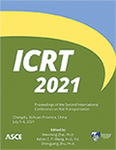Second International Conference on Rail Transportation
Regional Impact of Urban Rail Transit Network Accessibility on Residential Property Price
Publication: ICRT 2021
ABSTRACT
Urban rail transit can increase property prices by increasing higher accessibility and more activity opportunities in catchment areas. However, the high cost of construction and operation has become an important factor hindering the development of urban rail transit, especially in developing countries. Reliable measure of residential property appreciation can provide suggestions for rail transit planning and policy-making of value capture to fund rail transit. Despite numerous studies on the value-added of housing price in catchment areas, there are few studies on the relationship between the value-added of housing price and accessibility. In this research, we aim to investigate whether there is a significant relationship between urban rail transit network accessibility and residential property appreciation around each station and how such a relationship varies over time. We employed a generalized-travel-cost-based accessibility measure to capture the residential property appreciation using residential property price data of 2014 in Shanghai. The results indicate that there is a positive correlation between the rail transit network accessibility and residential property appreciation. Both of the accessibility improvement and residential property appreciation are bigger in suburban areas and smaller in city-center areas. This method can provide reference for urban rail transit planning and transit-oriented development.
Get full access to this article
View all available purchase options and get full access to this chapter.
References
Bardaka, E., Delgado, M.S., & Florax, R.J., 2018. Causal identification of transit-induced gentrification and spatial spillover effects: The case of the Denver light rail. Journal of Transport Geography, 71, 15–31.
Falcocchio, J.C., Malik, A., & Kontokosta, C.E., 2018. A data-driven methodology for equitable value-capture financing of public transit operations and maintenance. Transport Policy, 66, 107–115.
Hansen, W.G., 1959. How accessibility shapes land use. Journal of American Institute of Planners, 25(2), 73–76.
Hess, D. B., & Almeida, T. M., 2007. Impact of proximity to light rail rapid transit on station-area property values in Buffalo, New York. Urban Studies, 44(5–6), 1041–1068.
He, S.Y., 2020. Regional impact of rail network accessibility on residential property price: Modelling spatial heterogeneous capitalisation effects in Hong Kong. Transportation Research Part A-Policy and Practice, 135, 244–263.
Kay, A. I., Noland, R. B., & DiPetrillo, S., 2014. Residential property valuations near transit stations with transit-oriented development. Journal of Transport Geography, 39(0), 131–140.
Liang, Q., Kong, L., & Deng, W., 2007. Impact of URT on real estate value: the case of Beijing Metro Line 13. China Civil Engineering Journal, 40(4), 98–103.
Medda, F., 2012. Land value capture finance for transport accessibility: a review. Journal of Transport Geography, 25, 154–161.
Mathur, S., 2020. Impact of transit stations on house prices across entire price spectrum: A quantile regression approach. Land Use Policy, 99, 1–8.
McIntosh, J., Newman, P., Trubka, R., & Kenworthy, J., 2017. Framework for land value capture from investments in transit in car-dependent cities. Journal of Transport and Land use, 10(1), 155–185.
Pan, Q., 2013. The impacts of an urban light rail system on residential property values: a case study of the Houston Metrorail transit line. Transportation planning and technology, 36(2), 145–169.
Pan, Q., Pan, H., & Zhang, M., et al., 2014. Effects of Rail Transit on Residential Property Values: Comparison Study on the Rail Transit Lines in Houston, Texas, and Shanghai, China. Transportation Research Board, 2453, 118–127.
Qiao, Y., Peng, F., & Wang, Y., 2019. Valuing external benefits of underground rail transit in monetary terms: A practical method applied to Changzhou City. Tunnelling and Underground Space Technology, 83, 91–98.
Stull, M.A., 2008. Design considerations for a 21st century ground transportation system based on value-capture financing. Transportation planning and technology, 31(3), 249–275.
Sharma, R., & Newman, P., 2018. Does urban rail increase land value in emerging cities? Value uplift from Bangalore Metro. Transportation Research Part A-Policy and Practice, 117, 70–86.
Sun, J., Chen, T., & Cheng, Z., et al., 2017. A financing mode of Urban Rail transit based on land value capture: A case study in Wuhan City. Transport Policy, 57, 59–67.
Vu, T., & Preston, J., 2020. Assessing the social costs of urban transport infrastructure options in low and middle income countries. Transportation planning and technology, 43(4), 365–384.
Wu, Q., Ye, X., & Lin, X., 2014. Attraction Area Model for Urban Rail Transit Stations. Journal of Tongji University (Natural Science), 42(7), 1058–1063.
Wu, Q., & Ye, X., 2016. Analysis of Relationships between Urban Rail Transit Accessibility Improvement and Residential Property Appreciation. Journal of Tongji University (Natural Science), 44(6), 899–906.
Ye, X., & Cai, W., 2002. Calculation Method of Urban Rail Transit Development Benefits. Journal of Tongji University (Natural Science), 30(4), 431–436.
Yu, X., Zhong, H., Zhou, T., & Zhou, Y., 2018. Rail transit development in lagging regions: A development-oriented investment and financing approach. Journal of Transport and Land use, 11(1), 1003–1024.
Yang, L., Chen, Y., & Xu, N.et al., 2020. Place-varying impacts of urban rail transit on property prices in Shenzhen, China: Insights for value capture. Sustainable Cities and Society, 58, 1–9.
Zheng, J., 2004. The Relationship between Property Value and Urban Rapid Rail Transit: Based on Improved Hedonic Price Model. Tsinghua University, Beijing.
Information & Authors
Information
Published In
ICRT 2021
Pages: 525 - 536
Editors: Wanming Zhai, Ph.D., Southwest Jiaotong University, Kelvin C. P. Wang, Ph.D., Oklahoma State University, and Shengyang Zhu, Ph.D., Southwest Jiaotong University
ISBN (Online): 978-0-7844-8388-6
Copyright
© 2022 American Society of Civil Engineers.
History
Published online: Feb 8, 2022
Published in print: Feb 8, 2022
Authors
Metrics & Citations
Metrics
Citations
Download citation
If you have the appropriate software installed, you can download article citation data to the citation manager of your choice. Simply select your manager software from the list below and click Download.
